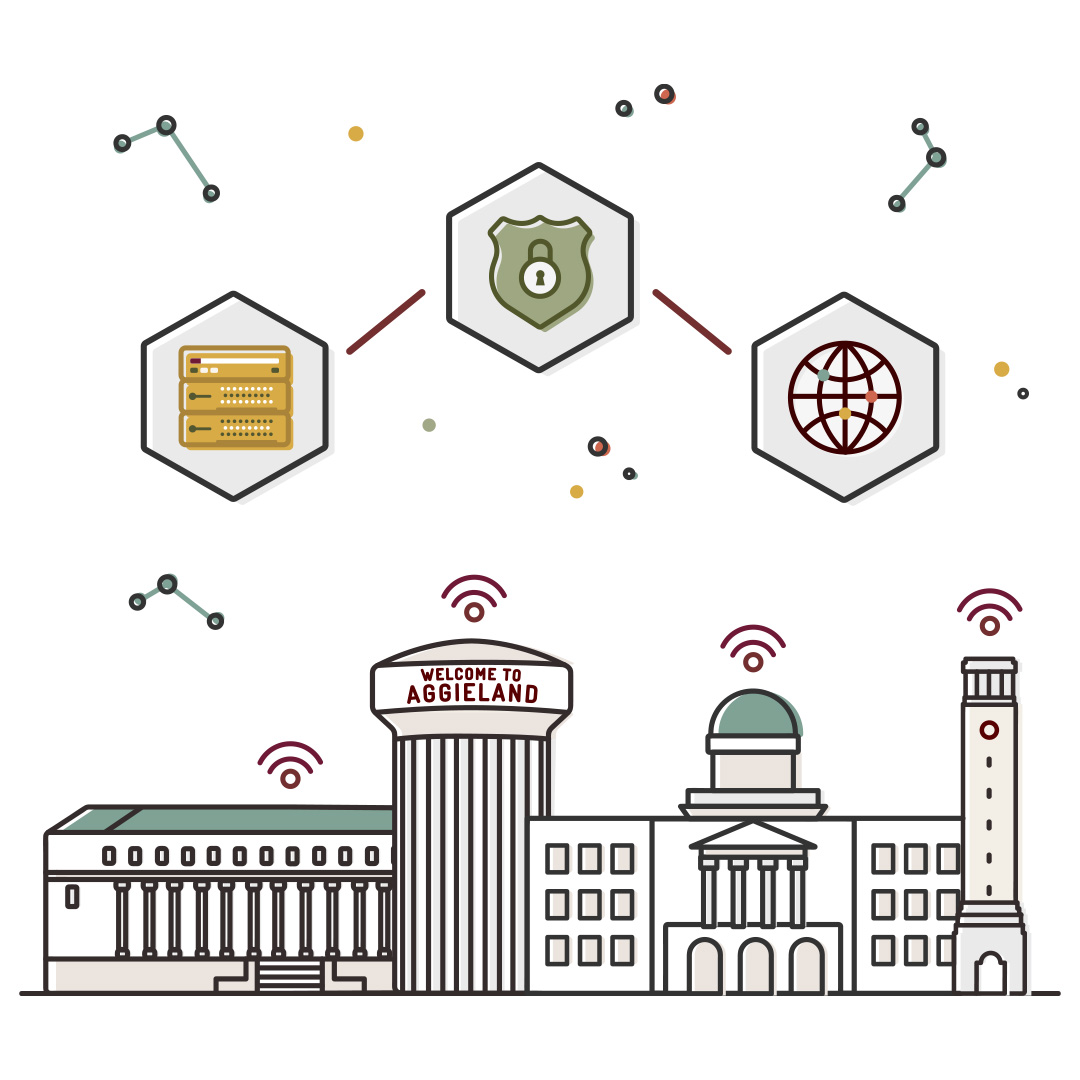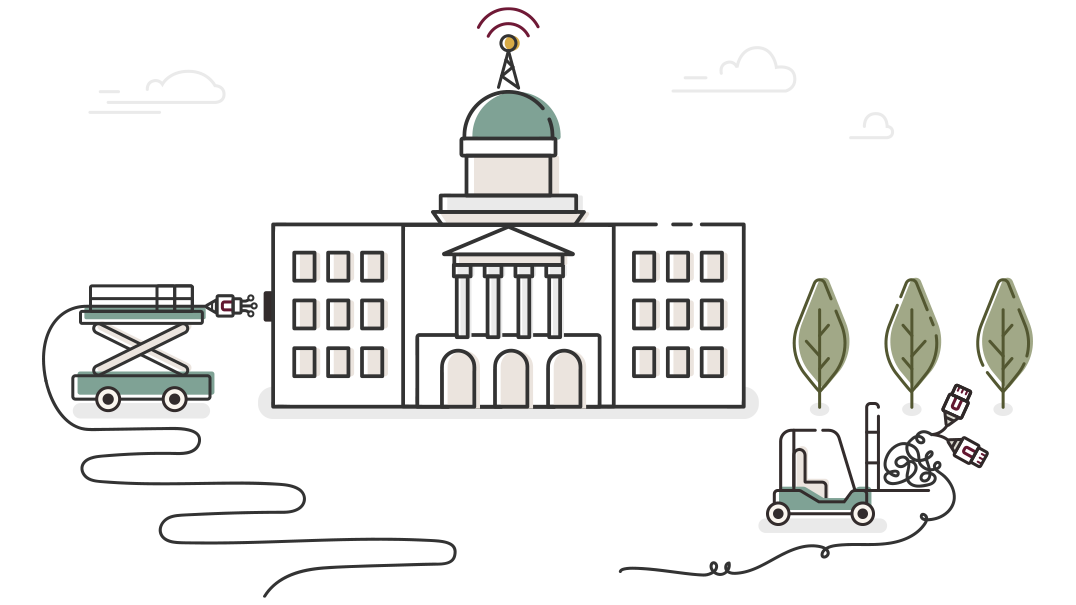Networking
Innovating the campus connection

Texas A&M University’s data network is the backbone of our campus technological infrastructure, seamlessly connecting employees and students to the resources, information and tools they need for academic, research and collaborative success.
Over the past year, Technology Services deployed a variety of network initiatives to strengthen, expand and modernize the campus network experience. These initiatives will lay down the groundwork for one of the largest network upgrades ever launched at Texas A&M, the Next Generation Aggie Network.
By design, the Next-Gen Network will transform the campus digital experience by providing faster, consistent wireless internet by utilizing 6E technology and expanding coverage in high-traffic outdoor areas. Upon project completion, Texas A&M will boast one of the most resilient and modern higher education campus networks in the country.
Other key actions include the expansion of the Internet of Things network in campus dorms, the launch of a new guest wireless experience, and the upgrade of legacy phones, switches, routers and access points across campus.
By investing in these robust, powerful and adaptable network upgrades, Texas A&M is poised to become the smart campus of tomorrow, meeting the future demands of Texas A&M educators, researchers and students with speed, agility and excellence.
Achievements

Next Generation Aggie Network
The Next Generation Aggie Network is a three-year, multi-million-dollar effort to modernize the Texas A&M University campus with 6E wireless technology and transform the campus digital experience by providing faster, consistent internet access across campus. It will expand Wi-Fi coverage in high-traffic outdoor areas and provide better support for data-intensive research efforts across the 5,200-acre campus.
As Technology Services prepares to launch the Next-Gen Network, approximately 240 buildings have had new fiber installed, which provides a consistent, high-speed fiber-optic backbone that allows for robust connectivity inside of each building. More than 7,000 wireless access points have been identified for upgrades and ultimately the number of access points will more than double, resulting in almost 20,000 6E wireless access points on campus. These access points will be installed by zones and will boost wireless coverage in needed areas identified through surveys.
Other examples of preparation happening across campus include work on the Texas A&M Health Science Center network, with the Next-Gen Network team proactively surveying wireless signals, network switches and equipment closets. This initiative will create network parity across the main Texas A&M campus and the Health Science Center. Phase 1 of the project is nearing completion with Phase 2 set to begin in 2023.
Streamlined guest wireless experience
In December 2022, Technology Services launched a redesigned and more secure guest wireless experience. The old process required visitors to submit an email or phone number to gain access to the internet. This was a slower process that required approval by campus cybersecurity. Now when campus visitors click to join the Texas A&M campus network, they are directed to a page asking them to agree to the terms and conditions, much like requesting to join a hotel guest network. Once guests have agreed to the terms of service, they are immediately granted five days of internet access. Guest wireless networks are necessary because they allow cybersecurity teams to restrict guest activity, giving visitors access to an internet connection and nothing else.
This new network also provides a more secure environment for visitors and campus members. All internet traffic is directed to a demilitarized zone (DMZ), a more secure and isolated area outside the front gates of a network’s firewall, giving Technology Services the ability to monitor traffic more efficiently. By streamlining and upgrading the guest wireless network, the Texas A&M campus community and its guests can continue with their visits as planned, in a more efficient and secure manner.
Partner Success
Internet of Things expands beyond dorms to classrooms

Over the past few years, the Internet of Things (IoT) has become one of the most pervasive technologies of the 21st century, giving us the ability to connect everyday objects such as TVs, speakers, wearables and even appliances to the internet.
In January 2021, Technology Services launched a pilot program for IoT in three residence halls and a handful of buildings on campus. The TAMU_IoT wireless network lets campus members connect smart devices that wouldn’t connect to TAMU_WiFi in the past, allowing the university to link each device to the user’s account to ensure the network remains secure.
More than 5,000 IoT devices have registered on the network since the fall 2021 semester and the demand continues to increase. Currently, students can connect up to five smart devices at a time to the internet.
In 2022, Technology Services expanded the IoT pilot network to a handful of buildings on campus, including Thompson and Fermer Halls. Research assistant and former Texas A&M engineering student Jorge Roa is a strong advocate for increasing the use of IoT in the classroom. “Further focus on IoT is essential to students’ futures in this field. It’s equipping them with more tools in their toolbox.”
The IoT network makes a dramatic difference in student capstone projects. By harnessing the functionality of IoT, students can expand their knowledge and usage of technologies they encounter in daily life. An example is the use of autonomous guided vehicles. Without IoT, they can drive around only with a routine path, but with IoT, they are able to interact in real-time with users’ voice-commands, just like a Google Home or an Echo Dot on wheels.
“IoT is one of the fastest-growing technologies, and it’s in high demand by everyone. It is our job to make sure the campus IoT network is both safe and effective,” said Networking Engineer Jacob Scoggins, who played an integral role in launching IoT on campus.
Bringing the IoT network to Texas A&M is more than an effort to stay relevant. Global access to IoT will change the game in education and research. For example, researchers and students working with “smart agriculture” can utilize robotic units and reporting devices to remotely analyze and log data from the field, storing information in the cloud or to a centralized service for researchers.
With IoT, the future of education and research technology, Technology Services is working to build a campus network where smart devices work seamlessly and securely.